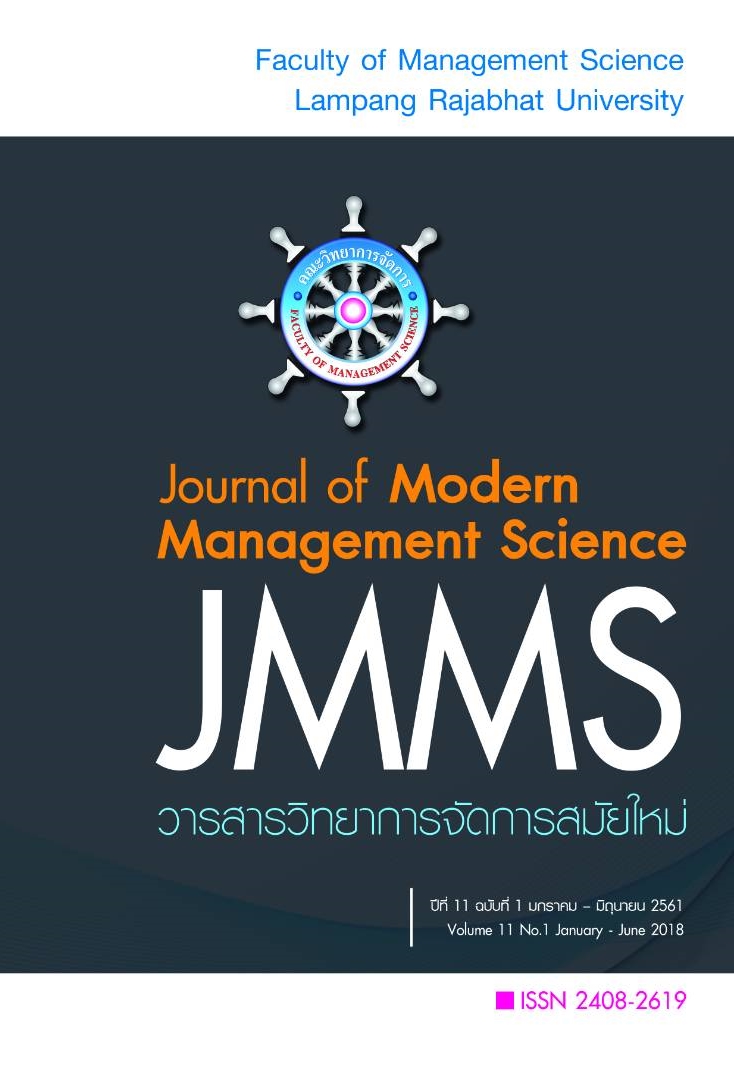Factors Influencing Personal Saving Behaviors of the Working-aged Population in the Lao People’s Democratic Republic
Main Article Content
Abstract
The purpose of this research is to study Factors Influencing Personal Saving Behaviors of the Working-aged Population in the Lao People’s Democratic Republic. Data are obtained from the questionnaire collection of 400 samples of 18 – 60 years old who are workers in Vientiane Capital. The research uses the Structural Equation Model (SEM) to analyze a causal relationship between the variables studied through the Amos statistical analysis program. The research finding reveals that saving-behavior was significantly direct influenced by attitudes-toward- saving, peer-influence and income factors in the positive way, these variables can explain the savings-behavior 67%. In addition the attitudes-toward-saving was significantly direct influenced by financial literature, peer-influence, self-control and education factors in the positive way. Moreover, the risk-tolerance factor influence significantly to attitude-toward-saving in the negative way. These variables can explain the attitudes-toward-saving 66%. Finding also reveals that the saving-behavior was significantly indirect influenced by financial literature, risk-tolerance, self-control, education and peer-influence factors through the attitude-toward-saving variable. However, finding shows that age and number of dependents factors were not significantly direct and indirect influence on both attitudes-toward-saving and saving-behavior.
Article Details
The article must be considered and accepted for publication by the editorial board of the Faculty of Management Science, Lampang Rajabhat University. The articles have been reviewed by a peer (peer review) and the author must update according to the suggestion if available before publication. Articles that are not considered the editorial team will inform the results of the consideration but will not send the original to the author.
JMMS is the Faculty of Management Science journal, Lampang Rajabhat University. Jmms published both print and online editions. We allow the use of articles for academic use under the scope of copyright law.
References
ฐิติพร ศรีชัยชนะ. (2550). ความสัมพันธ์ของการออมภาครัวเรือนกับแนวคิดเศรษฐกิจพอเพียง: กรณีศึกษาจังหวัดพิษณุโลก. มหาวิทยาลัยนเรศวร จังหวัดพิษณุโลก.
ดวงเดือน พันธุมนาวิน. (2541). รูปแบบปฏิสัมพันธ์นิยมเพื่อการวิจัยสาเหตุของพฤติกรรมและการพัฒนาพฤติกรรมมนุษย์. วารสารทันตาภิบาล, 10(2): 105-108.
ทิพย์สุดา จันทร์แจ่มหล้า. (2544). ปัจจัยด้านจิตสังคมของผู้ดูแลที่เกี่ยวข้องกับพฤติกรรมให้การสนับสนุนทางสังคมแก่ผู้ติดเชื้อเอดส์. สาขาวิจัยพฤติกรรมศาสตร์ประยุกต์. มหาวิทยาลัยศรีนครินทรวิโรฒ.
ปรเมศวร์ ว่องพิริยพงศ์. (2551). การออมและการลงทุนของพนักงานภาคเอกชน. หลักสูตรปริญญาเศรษฐศาสตร์มหาบัณฑิต, สาขาวิชาเศรษฐศาสตร์การจัดการ. มหาวิทยาลัยศรีนครินทรวิโรฒ.
พงศกร สุริยพงค์ประไพ และ ศรีสิทธิ อังศุโภไคย. (2556). ปัจจัยที่ส่งผลกระทบต่อพฤติกรรมการออมของพนักงานธนาคารออมสินสำนักงานใหญ่. หลักสูตรบริหารธุรกิจบัณฑิต สาขาวิชาการจัดการธุรกิจทั่วไป คณะวิทยาการจัดการ. มหาวิทยาลัยศิลปากร.
พนม กิติวัง. (2543). พฤติกรรมการออมของครัวเรือนในเขตเทศบาลนครเชียงใหม่. วิทยานิพนธ์ เศรษฐศาสตร์มหาบัณฑิต. มหาวิทยาลัยเชียงใหม่.
โสภณ โรจน์ธํารง. (2529). พฤติกรรมการออมของครัวเรือนในภาคตะวันออกเฉียงเหนือ. วิทยานิพนธ์ เศรษฐศาสตร์มหาบัณฑิต. มหาวิทยาลัยธรรมศาสตร์.
Allen, R., & Santrock, J. W. (1993). Psychology: The Contexts of Behavior. USA: Wm. C. Brown Communication.
Bajtelsmit, V. L., & Van Derhei, J. L. (1997). Risk Aversion and Pension Investment Choices in Positioning Pensions for the Twenty-first Century. University of Pennsylvania Press, 45-66.
Baumeister, R. F. (2002). Self – Control Failure, Impulsive Purchasing, and Consumer Behavior. The Journal of Consumer Research, the University of Chicago Press, 28(4): 670 – 676.
Browning, M. (1995). Saving and the Intra-household Distribution of Income: An Empirical Investigation. Richerche Economiche, 48: 277–292.
Browning, M., & Lusardi, A. (1996). Household Saving: Micro Theories and Micro Facts. Journal of Economic Literature, 34(4): 1797-1855.
Burbridge, J. B., & Robb, A. L. (1985). Evidence on Wealth-age Profiles in Canadian Cross- Section Data. Canadian Journal of Economics, 18(4): 854–875.
Chai Ming, T., Chia Ying, K., Fong Sheng, N., Lew Wan, C., & Tan Chang, T. (2012). Determinants of Saving Behavior among the University Students in Malaysia. Faculty of Business and Finance Department of Commerce and Accounting, University of Tunku Abdul Rahman.
Danzinger, S., Gaag, J. van der, Smolensky, E., & Taussig, M. K. (1982). The Life-Cycle Hypothesis and the Consumption Behavior of the Elderly. Journal of Post-Keynesian Economics, 5: 208–227.
Droms, W. G. (1987). Investment Asset Allocation for PFP Clients. Journal of Accountancy, 163(4): 114–118.
Duflo, E., & Saez, E. (2001). the Role of Information and Social Interactions in Retirement Plan Decisions: Evidence from a Randomized Experiment. National Bureau of Economic Studies Working Paper, 8885.
Esenvalde, I. (2010). Psychological Predictors of Saving Behavior: Contrasting the Impact of Optimism and Burnout on Self-control, Achievement Motivation and Savings Behavior. Dissertation, Alliant International University, Los Angeles, 3452407, 153.
Grabe, J. E., & Joo, S. (1997). How to Improve Financial Knowledge, Attitudes, and Behaviors among Consumer Science Constituencies. The Journal of Consumer Education, 17: 20-26.
Guariglia, A., & M. Rossi. (2002). Consumption, Habit Formation, and Precautionary Saving: Evidence from the British Household Panel Survey. Oxford Economic Papers, 54: 1–19.
Hogarth, J. M. (2002). Financial Literacy and Family and Consumer Sciences. Journal of Family and Consumer Sciences, 94: 15-28.
Hilgert, M. A., Hogarth, J. M., & Beverly, S. G. (2003). Household Financial Management: The Connection between Knowledge and Behavior. Fed. Res. Bull, 89: 309-322.
Hurd, M. D. (1987). Saving of the Elderly and Desired Bequests. American Economic Review, 77(3): 298–312.
Lim, C. S., Sia, B. K., & Gan, G. J. (2011). The Analysis of Psychological Factors Affecting Savers in Malaysia. Middle Easter Finance and Economic, 12: 77-85.
Lusardi. A., & Mitchell, O. S. (2006). Financial Literacy and Planning: Implications for Retirement Wellbeing. Department of Economics, Dartmouth College.
Mahdzan, N. S., & Tabiani, S. (2013). The Impact of Financial Literacy on Individual Saving: an Exploratory Study in the Malaysian Context. Transformations in Business and Economic, 12(1): 41-55.
Sabri, M. F., & MacDonald, M. (2010). Savings Behavior and Financial Problems among College Students: The Role of Financial Literacy in Malaysia. Cross-Cultural Communication, 6(3): 103-110.
Schagen, S., & Lines, A. (1996). Financial Literacy in Adult Life: a Report to the NatWest Group Charitable Trust, National Foundation for Educational Research.
Sherman, D. H., Kim, K. T., & Liu, F. (2001). Parameter Assumptions in Normative Analyses of Household Financial Decisions. Normative analyses of household financial decisions typically assume, the Ohio State University.
Shiyu Yu, J. T. (2011). A Study of Students' Saving Behavior, Attitude towards Saving and Motivation to Save. The Umea School of Business.
Teresa, M., Garcia, M., Barros, C., & Selvestre, A. (2011). Saving Behavior: Evidence from Portugal. International Review of Applied Economics, 25(2): 225-238.
Yamane, T. (1967). An Introductory Analysis. New York: Harper and Row.


